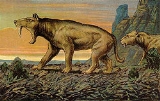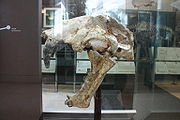
Machairodus
Encyclopedia
Machairodus was a genus of large machairodontine
saber-toothed cat
s that lived in Europe
, Asia
, Africa
and North America
during the Miocene
through Pleistocene
living from 11.6mya—126,000 years ago, existing for approximately .
 The fossil species assigned to the genus Machairodus were divided by Turner into two grades of evolutionary development - M. aphanistus and the North American "Nimravides" catacopis representing the more primitive grade, and M. coloradensis and M. giganteus representing the more derived grade. The characteristics of the more advanced grade include a relative elongation of the forearm and a shortening of the lumbar region of the spine to resemble that in living pantherine cats. These trends would be taken further in Homotherium, which is thought to have evolved from Machairodus.
The fossil species assigned to the genus Machairodus were divided by Turner into two grades of evolutionary development - M. aphanistus and the North American "Nimravides" catacopis representing the more primitive grade, and M. coloradensis and M. giganteus representing the more derived grade. The characteristics of the more advanced grade include a relative elongation of the forearm and a shortening of the lumbar region of the spine to resemble that in living pantherine cats. These trends would be taken further in Homotherium, which is thought to have evolved from Machairodus.
The skull of Machairodus was noticeably narrow compared with the skulls of modern pantherine big cats, and the orbits were relatively small. The canines were long, thin and flattened from side to side but broad from front to back like the blade of a knife, as in Homotherium. The front and back edges of the canines were serrated when they first grew, but these serrations were worn down in the first few years of the animal's life.
There was marked sexual dimorphism in Machairodus giganteus, with males much larger than females.
A single fossil specimen examined by Legendre and Roth was determined to have an approximate body mass of 201.8 kg.
Machairodus was about 2M long and probably hunted as an ambush predator. Its legs were too short to sustain a long chase, so it most likely was a good jumper, and used its canines to cut open the throat of its prey. Its teeth were rooted to its mouth and were not too delicate, unlike most saber-toothed cats of the time, which had extremely long canines which hung out of their mouths. The machairodus' fangs, however, were able to more easily fit in its mouth comfortably while being long and effective for hunting.
Machairodontinae
Machairodontinae is an extinct carnivoran mammal subfamily of Felidae endemic to Asia, Africa, North America, South America, and Europe from the Miocene to Pleistocene living from c. 23 Ma until c...
saber-toothed cat
Saber-toothed cat
Saber-toothed cat or Sabre-toothed cat refers to the extinct subfamilies of Machairodontinae , Barbourofelidae , and Nimravidae as well as two families related to marsupials that were found worldwide from the Eocene Epoch to the end of the Pleistocene Epoch ,...
s that lived in Europe
Europe
Europe is, by convention, one of the world's seven continents. Comprising the westernmost peninsula of Eurasia, Europe is generally 'divided' from Asia to its east by the watershed divides of the Ural and Caucasus Mountains, the Ural River, the Caspian and Black Seas, and the waterways connecting...
, Asia
Asia
Asia is the world's largest and most populous continent, located primarily in the eastern and northern hemispheres. It covers 8.7% of the Earth's total surface area and with approximately 3.879 billion people, it hosts 60% of the world's current human population...
, Africa
Africa
Africa is the world's second largest and second most populous continent, after Asia. At about 30.2 million km² including adjacent islands, it covers 6% of the Earth's total surface area and 20.4% of the total land area...
and North America
North America
North America is a continent wholly within the Northern Hemisphere and almost wholly within the Western Hemisphere. It is also considered a northern subcontinent of the Americas...
during the Miocene
Miocene
The Miocene is a geological epoch of the Neogene Period and extends from about . The Miocene was named by Sir Charles Lyell. Its name comes from the Greek words and and means "less recent" because it has 18% fewer modern sea invertebrates than the Pliocene. The Miocene follows the Oligocene...
through Pleistocene
Pleistocene
The Pleistocene is the epoch from 2,588,000 to 11,700 years BP that spans the world's recent period of repeated glaciations. The name pleistocene is derived from the Greek and ....
living from 11.6mya—126,000 years ago, existing for approximately .
Species

Anatomy
"Nimravides" catacopis stood about 1 m at the shoulder. Machairodus coloradensis was apparently significantly larger, about 1.2 m at the shoulder, according to skeletal and life reconstructions. If accurate, this would make M. coloradensis one of the largest felids.The skull of Machairodus was noticeably narrow compared with the skulls of modern pantherine big cats, and the orbits were relatively small. The canines were long, thin and flattened from side to side but broad from front to back like the blade of a knife, as in Homotherium. The front and back edges of the canines were serrated when they first grew, but these serrations were worn down in the first few years of the animal's life.
There was marked sexual dimorphism in Machairodus giganteus, with males much larger than females.
A single fossil specimen examined by Legendre and Roth was determined to have an approximate body mass of 201.8 kg.
Machairodus was about 2M long and probably hunted as an ambush predator. Its legs were too short to sustain a long chase, so it most likely was a good jumper, and used its canines to cut open the throat of its prey. Its teeth were rooted to its mouth and were not too delicate, unlike most saber-toothed cats of the time, which had extremely long canines which hung out of their mouths. The machairodus' fangs, however, were able to more easily fit in its mouth comfortably while being long and effective for hunting.

